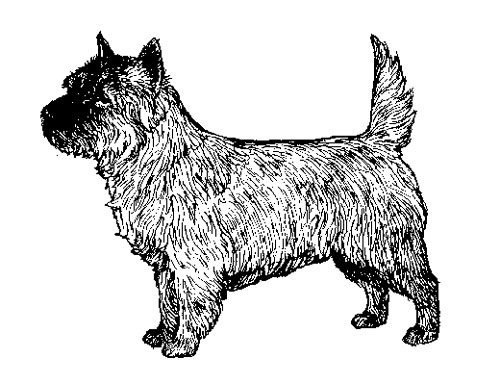Cairn Terrier
Terrier Group
The goals and purposes of this breed standard include: to furnish guidelines for breeders who wish to maintain the quality of their breed and to improve it; to advance this breed to a state of similarity throughout the world; and to act as a guide for judges.
Breeders and judges have the responsibility to avoid any conditions or exaggerations that are detrimental to the health, welfare, essence and soundness of this breed, and must take the responsibility to see that these are not perpetuated.
Any departure from the following should be considered a fault, and the seriousness with which the fault should be regarded should be in exact proportion to its degree and its effect upon the health and welfare of the dog and on the dog’s ability to perform its traditional work.
History
The Cairn Terrier was developed in Scotland to hunt otter, fox and other vermin along the shoreline. The Scottish, West Highland White and Cairn terriers were developed from the same stock, first called Scotch terriers and later Skye terriers. The three were often found in the same litter, distinguished only by color.
The Cairn first competed for challenge certificates in England in 1912.
The Cairn Terrier was recognized by the United Kennel Club in 1959.
General Appearance
A small working terrier, agile and alert, with a shaggy, weather resistant coat and a natural appearance.
Characteristics
Active and game, with a fearless, gay but not aggressive disposition.
Head
The head is shorter and wider than on any of the other terriers, and well furnished with hair, giving the dog a somewhat foxy expression.
SKULL
Is broad in proportion to its length and there is a decided stop.
MUZZLE
Powerful, with strong jaws, but they are not long or heavy.
TEETH
A full complement of strong, large, white teeth meet in a scissors bite.
EYES
Set wide apart and fairly deep, medium in size, dark hazel in color. Shaggy eyebrows.
NOSE
Black.
EARS
Small and pointed, well carried and erect. Not too closely set nor heavily furnished.
Neck
Well set on, not short.
Forequarters
Sloping shoulders.
FORELEGS
Medium length of leg with good, but not too heavy bone. Forelegs never out at the elbows. Legs perfectly straight, but feet may turn slightly out. Covered with harsh hair.
Body
The back is level, of medium length, and ribs are well sprung and deep. Strong, supple loin.
Hindquarters
HIND LEGS
Very strong and muscular thighs. Good, but not excessive bend of stifle. Hocks well let down, inclining neither in nor out when viewed from the rear.
Feet
Thick, strong pads. Forefeet larger than hind feet. Thin or splayed feet are objectionable.
Tail
Short, in balance with the head, well furnished with hair, but not feathery. Neither high nor low set, carried gaily, but not curled over back.
Coat
Very important. Weather resistant. Must be double coated with profuse, harsh, but not coarse, outer coat; undercoat short, soft and close. A slight wave is permissible. Open coats are objectionable.
Color
Cream, wheaten, red, gray or nearly black. Brindling in these colors acceptable. Dark ears, muzzle and tail tip are typical.
Height & Weight
Height: 11 to 12 inches in height.
Weight: 14 to 16 pounds in weight.
Gait
Free flowing, with good reach and drive.
Disqualifications
(A dog with a Disqualification must not be considered for placement in a conformation event, and must be reported to UKC.)
Unilateral or bilateral cryptorchid. Viciousness or extreme shyness. Albinism.

Looking for a Dog?
Find a dog that will fit your family.
Note: The breeders on this list are not endorsed by UKC.
Revised April 15, 2007
©Copyright 1992, United Kennel Club
